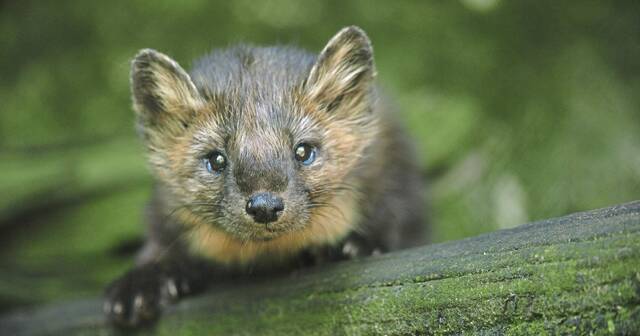Despite support, state game commission puts hold on marten reintroduction plan
A plan to reintroduce a native species of weasel into the Pennsylvania wild is on hold indefinitely as the majority of the state Game Commission’s board of commissioners again asked for more time.
Commissioner Dennis Fredericks said he was satisfied with the American marten reintroduction plan but sought the postponement because other board members weren’t as convinced.
“Please don’t anybody get bent out of shape about that language — postponed indefinitely,” he said during Saturday’s board meeting. “That doesn’t mean that we won’t be well informed by July or September, but … there’s some of us that feel they need more information. And again … it’s an effort on our part to convince you that we hear you on each and every issue.”
Westmoreland County is among the expected placement sites.
The group voted 6-3 to put the plan on hold indefinitely after several people spoke in favor it. Mike Spittle, vice president east of the Pennsylvania Trappers Association, said he takes the opportunity to talk with members of the public about the proposal during events.
“Most of the people that I’ve run across in doing these things are in favor of this program,” he said. “The small handful … that are adamantly opposed to this project are grossly misinformed.”
But it’s that minority that some commissioners are still hoping to reach by pushing off a decision on the plan.
Commission officials have been working on the proposal since 2022 to reintroduce the American marten, or pine marten, back into the wild after its disappearance more than 100 years ago. The board approved in September a draft 10-year strategic plan that outlined how the species would be relocated to Pennsylvania and managed.
The plan was put on hold by a majority of the commissioners in January. During Saturday’s meeting, some discussed efforts since then to educate members of the public and gather more information about the proposal.
“I believe in a short amount of time we will have an affirmative decision,” Commissioner Scott Foradora said.
Other commissioners said they felt confident approving the measure now.
“I think the plan is straight forward, it answers all the questions,” Commissioner Haley Sankey said. “I’m not a patient person and I think we’ve been patient enough and I’d love to see this move forward as it is.”
Majority support
A majority of those who talked about the marten’s reintroduction during public comment were in support of the plan.
John Bingaman, state director of Hunter Nation Pennsylvania, said he doesn’t think the reintroduction will be an issue.
“Our membership is 90% in support of the marten, knowing that this study came from one of the highest ranking wildlife agencies in the country,” he said. “We know it will be handled correctly.”
Bridget Reheard, president of the Penn State Student Chapter of The Wildlife Society, said the commission has a unique opportunity to improve biodiversity.
“My generation … (is) abundantly in support of returning the state to natural conditions,” she said. “We acknowledge the uncertainty of this project, but we do know that many extirpated species that we have reintroduced, such as the turkey, once co-existed and thrived with the currently extirpated American marten.”
Mark Weidner said sportsmen he represents in Eastern Pennsylvania’s Northampton County are opposed to the plan.
“I think that we should be spending more money on our game lands and creating habitat for species to live and feed on,” he said.
High-priority locations
There are several high-priority locations of public lands in Northcentral Pennsylvania that were identified as potential release sites for the omnivorous martens. The ridges of Westmoreland County also would be a suitable habitat, according to the draft plan.
Martens are about 2 pounds — the size of a squirrel or mink — and disappeared from the state around 1900, during a period of deforestation and unregulated harvest, according to the Game Commission.
A minimum of 300 martens would be needed for reintroduction, according to the draft plan. They would be tracked through electronic tags implanted under the skin in a project expected to cost about $2 million over 10 years.
The animals live in forested areas that receive more than 35 inches of snow annually. The plan found martens typically hunted and ate small mammals, such as mice, and plant material and insects.
Renatta Signorini is a TribLive reporter covering breaking news, crime, courts and Jeannette. She has been working at the Trib since 2005. She can be reached at rsignorini@triblive.com.
Remove the ads from your TribLIVE reading experience but still support the journalists who create the content with TribLIVE Ad-Free.

